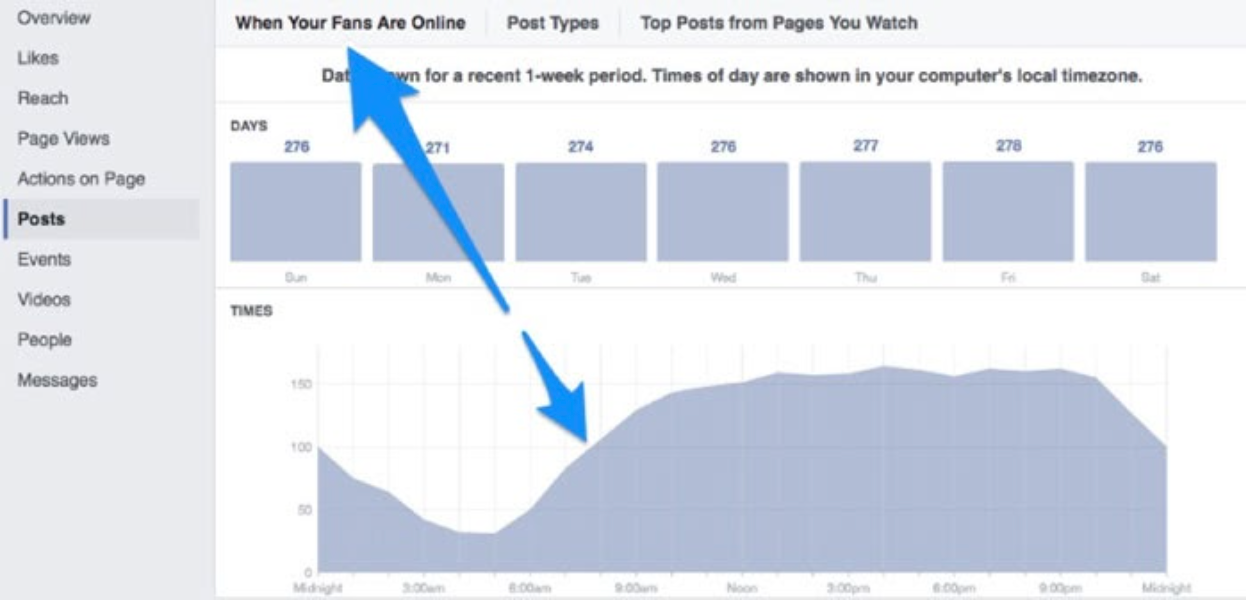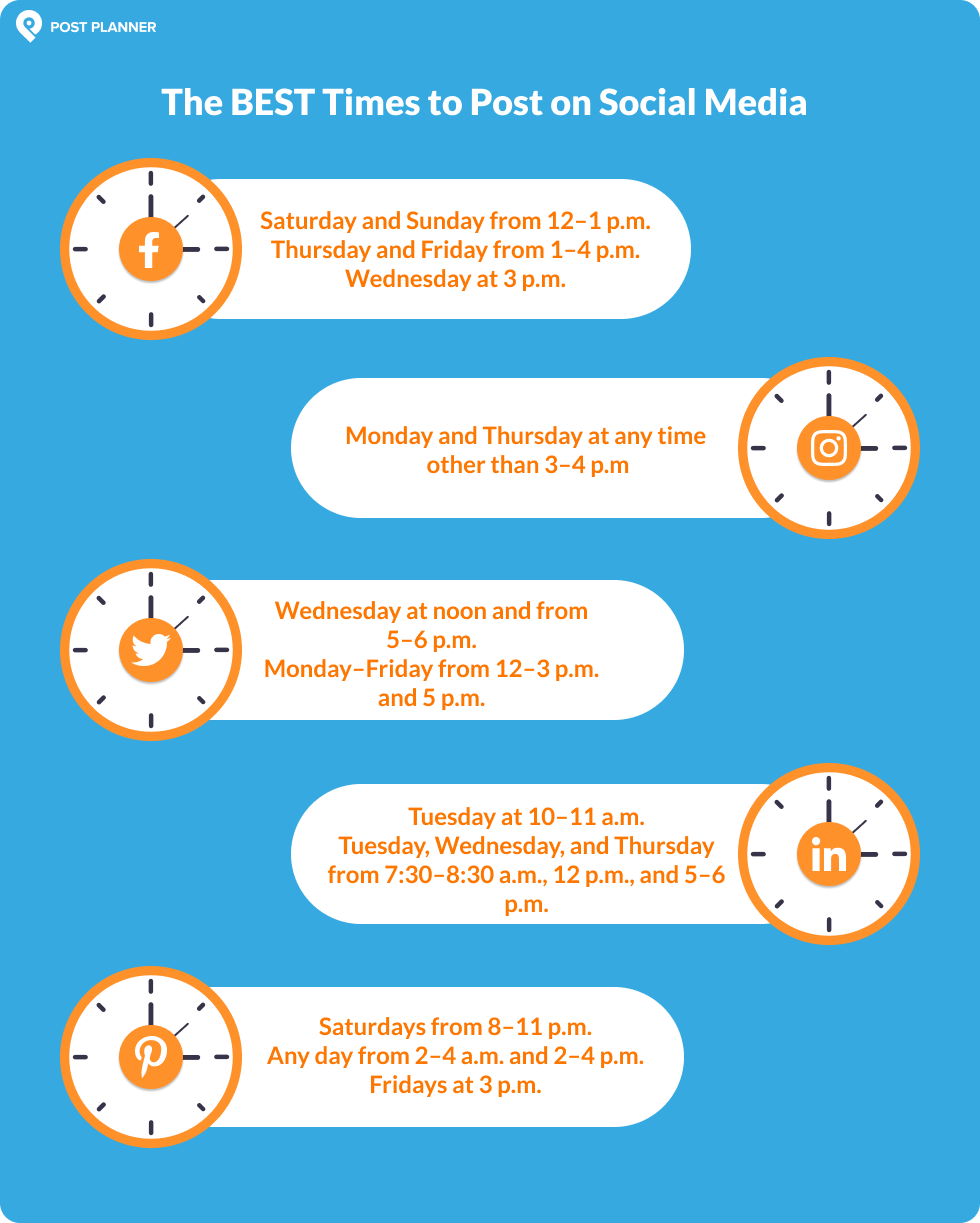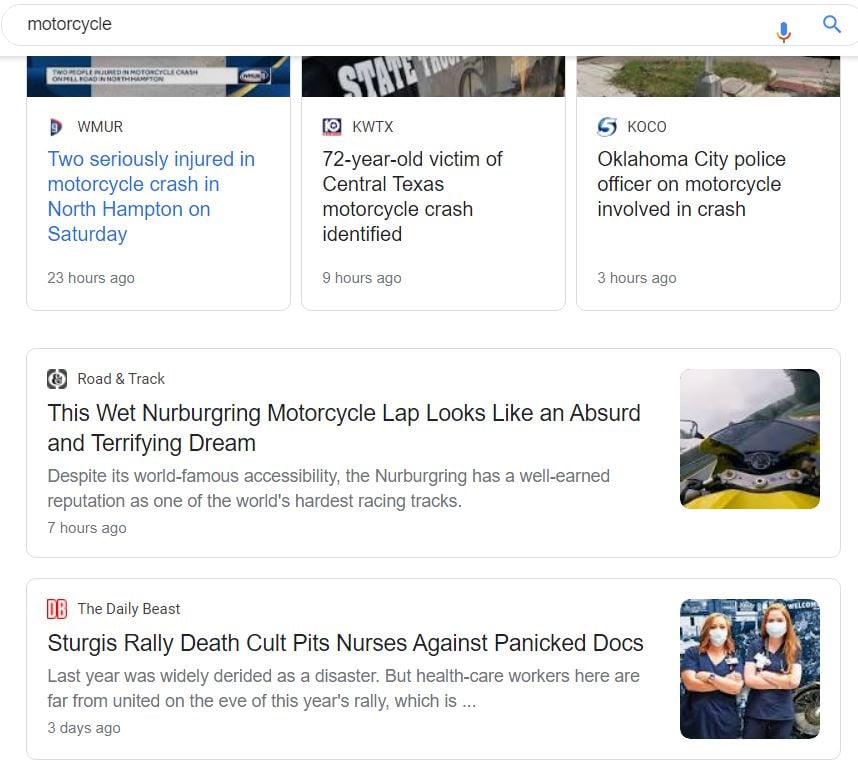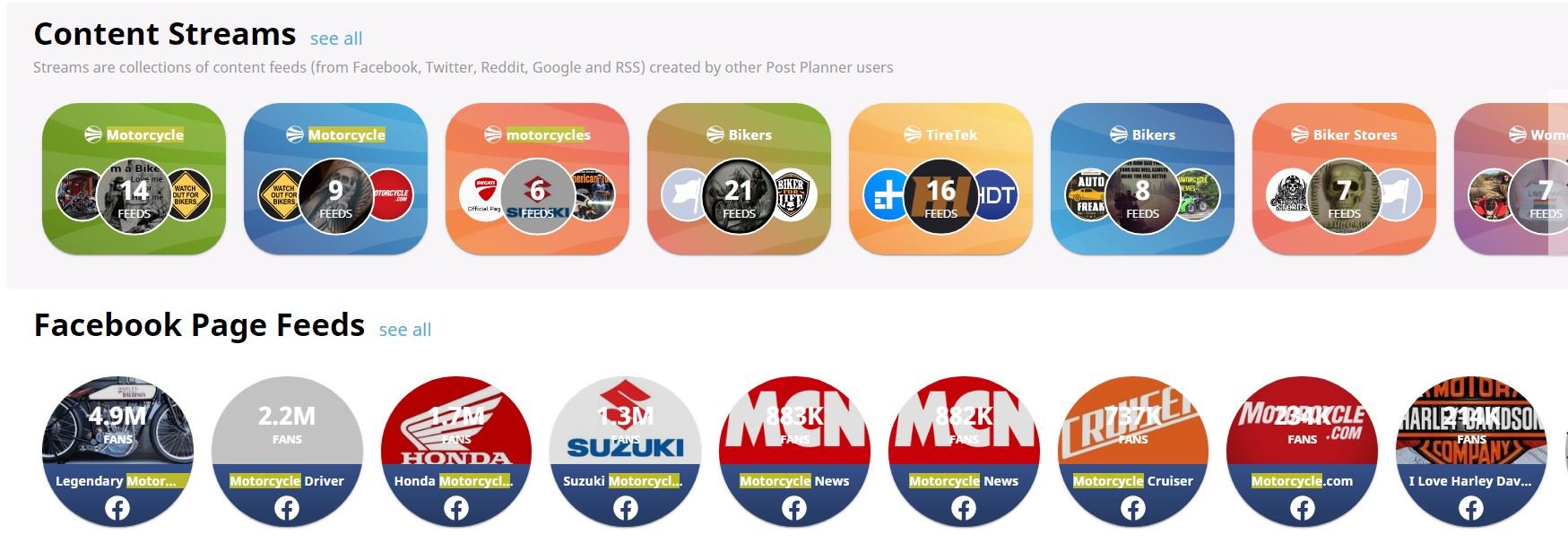

It's Thursday afternoon.
You know from your Facebook Insights that your audience is online right now.
This is the perfect time to post on social media.
There’s only one problem: you don’t have anything ready to post.
You stop what you're doing and go into panic mode.
You want to find the right piece of content to post (and fast!).
After 10 minutes of frantic searching, you find a decent (but not great) piece of content.
Finally, you post it to your Facebook and relax.
Sound familiar? We've all been there.
This post will show you exactly how to make a social media posting schedule that will drastically reduce your stress while improving engagement.
Want to cut down on scheduling time while boosting your social media engagement?
Click here to try our scheduling tool for FREE!
How to Make the Best Social Media Posting Schedule to Reach Your Audience
Manually looking for content and posting on social media every day gets stressful.
Even worse, you'll get burned out, and posting on your social media platforms won't be fun anymore!
Unless you’re a glutton for pain and stress, you’ll stop posting.
Then, you’ll lose out on that vast potential audience.
It doesn't have to be that way!
You just need a social media schedule!
A social media schedule can help you reduce your time spent working on social media posts.
And all that time you get so save by using a social media calendar?
You can use it to INTERACT with your audience.
For example, you can:
- Answer questions
- Develop relationships
- Participate in conversations
You can do all that while being confident that your scheduler will automatically publish your hand-selected content at strategic times.
Is it starting to make sense?
That's what happens when you schedule social media posts. It takes a massive weight off your shoulders (and saves you a ton of time)!
In this post, we’ll answer these questions so you can schedule social media posts like a pro:
- What’s a social media schedule?
- Does timing matter when posting on social media?
- How often should I post on social media?
- How do I create a social media posting schedule?
- Is Post Planner the best platform for social media scheduling?
Let's get started!
What is a social media schedule?
Hopefully, the potential benefits of a social media posting schedule have piqued your interest.
But there is often confusion about what a social media schedule does (and what it doesn’t do).
Put simply, a social media schedule allows you to decide what you’ll post and when you’ll post it weeks or months in advance.
Even a simple social media calendar can significantly simplify and improve your social media process.
However, that only begins to scratch the surface of what social media scheduling can offer your business.
Let’s look more closely at how a social media calendar can improve your business’s online presence.
Then, we’ll show you how to make the best social media posting schedule to grow your audience and engagement.
1. Social media scheduling tools give you more time for other important tasks
Once you start scheduling your posts in advance, you'll have more time to:
- Interact with your audience
- Write a blog post
- Do some testing
- Make new connections
- Have a cup of coffee
 Even if you choose not to automate your posting schedule with social media scheduling tools (which we’ll talk about in a minute), you’ll still save tons of time.
Even if you choose not to automate your posting schedule with social media scheduling tools (which we’ll talk about in a minute), you’ll still save tons of time.
A scheduling tool will post your content for you (even while you're away from your desk).
Automated social media posting will save you even more time!
And that’s the BIGGEST reason to schedule social media posts:
To regain control of your time!
You'll be able to overcome the massive social media time suck many people experience daily.
2. Scheduling encourages consistency
As with many other things, consistency is vital on social media.
Consistent posting keeps your name in front of your customers.
Over time, consistency will grow your follower base and improve your engagement numbers.
The only problem is that it’s EXTREMELY difficult to post consistently without a plan in place.
A social media schedule helps you know exactly when you’re supposed to post and allows you to collect content ahead of time!
If you're using social media for your business, remaining active and engaged is essential!
3. Have content ready to post ahead of time
Creating a schedule forces you to plan your content ahead of time!
If you’re anything like me, you tend to procrastinate.
You get to the last minute, then realize that you haven’t decided what you’re going to post to your social media accounts.
Not only does that stress you out, but it decreases the quality of your content as well.
Looking for content weeks in advance gives you plenty of time to find the PERFECT pieces for your audience.
If you use a scheduling tool like Post Planner, it’s even easier to find content that will perform well with your audience.
4. Keep track of posted content
When you create a social media posting schedule, you can easily look back on what you posted (without having to scroll through endless social media feeds).
However, the real benefit comes in when you use social media scheduling tools.
A good tool will allow you to see the engagement metrics for each of the posts that you’ve made.
Measuring each post’s success is key to making an even better content strategy.
For example, let’s say you have a business about health.
If you post about the health benefits of coffee and it’s a slam dunk, you now know that coffee content performs well with your audience.
From now on, you’ll be able to post more content about coffee, which will boost your engagement metrics over time.
5. Repurpose or recycle your content with ease
If a piece of content performs well, do you have to find a piece EXACTLY like it to post again?
Not exactly.
But you CAN recycle the earlier post!
That may sound like cheating, but it’s a beneficial practice when you want to post a tried-and-true piece of content.
Since a social media schedule helps you gauge a post’s success, it helps you know when to recycle (post again) your best content.
Social media scheduling tools make this even easier by giving you easy access to old posts and helping you recycle them later.

Does timing matter when posting on social media?
If you had to guess how long a tweet’s “life” (timespan in which it remains influential) lasts, what would you say?
A day? 2 days? A week?
The lifespan of your social media posts is shorter than you probably realize.
Yep. Your tweet lasts about 24 minutes before it “dies” and will no longer continue growing.
Facebook isn’t much better. The lifespan of the average post is just 90 minutes.
If you want to get noticed on Facebook or in that fast-moving Twitter stream, it's crucial to post at just the right time!
When you consider how many people are competing for our attention on social media, you start to understand the importance of posting at the optimal time.
When you find the best times to post, you'll increase web traffic, engagement, and social shares!
When is the best time to post?
That's a great question, and there’s more than one way to answer it.
Unfortunately, there is no one-size-fits-all answer that will magically flood your social media with traffic.
You’ll have to do the heavy lifting yourself.
Use tools like Facebook Insights and Twitter Analytics to find out exactly when your audience is online.
If you post just before your audience logs on, you’ll have the best chance of getting your post in front of them.

Even though every audience is different, some general rules may be helpful for you at the start:
- Saturday and Sunday from 12–1 p.m.
- Thursday and Friday from 1–4 p.m.
- Wednesday at 3 p.m.
- Wednesday at noon and from 5–6 p.m.
- Monday–Friday from 12–3 p.m. and 5 p.m.
- Experiment with 2–3 a.m., 6–7 a.m., and 9–10 p.m.
- Tuesday at 10–11 a.m.
- Tuesday, Wednesday, and Thursday from 7:30–8:30 a.m., 12 p.m., and 5–6 p.m.
- Saturdays from 8–11 p.m.
- Any day from 2–4 a.m. and 2–4 p.m.
- Fridays at 3 p.m.
- Monday and Thursday at any time other than 3–4 p.m
That’s a lot of information!
Remember, those are just guidelines to help you get started.
The only way to know for sure when you should post is by looking at your engagement numbers.
Experiment with different posting days and times.
When you come across times that seem to improve your engagement, stick to them!
In other words, IT MATTERS WHEN YOU POST!
However, every audience is different.
Learn your audience’s online habits, and you’ll generate higher engagement than ever before.
How often should I post on social media?
Another great question!
Unfortunately, it’s another question that doesn’t have a precise answer!
Again: EVERY AUDIENCE IS DIFFERENT!
However, some studies make helpful suggestions for how often you should post on social media.
 Consider following these general rules (especially when you’re just starting):
Consider following these general rules (especially when you’re just starting):
- Facebook: Post once per day. At a minimum, post 3 times per week. If you post less than 3 times per week, you’re giving your audience too much time to forget you in between posts.
- Twitter: Remember, your tweets only last about 24 minutes each, so you should be posting more often on Twitter than on Facebook. Post about 10 times a day to start, then go up from there as you experiment.
- Pinterest: Post about 10 times per day. Not all of those have to be original pins. In fact, most of them should be repinned content from other sources.
- Instagram: Post at least once per day on Instagram. We recommend either 1 or 2 posts per day to remain consistent but avoid annoying your followers.
How do I create a social media posting schedule?
By now, I KNOW you’re convinced that you need a social media posting schedule.
Without one, you just can’t tap into social media’s full potential for your business.
It’s impossible to consider posting times, posting frequencies, content, audience interaction, and more without planning ahead.
Now comes the fun part: learning how to actually make a posting schedule!
First, we’re going to go through the basic steps of making an excellent posting schedule. Then, we’re going to show you how to make the world’s best social media posting schedule using Post Planner.
1. Plan your posting times
First things first: you need to decide when you’re going to post on each social media channel.
If you skipped to this part of the article, go back and read the sections titled “Does timing matter when posting on social media?” and “How often should I post on social media?”
If you choose not to use Post Planner, the best way to plan your posting times is by opening a Google Calendar and creating an event for each posting time.
 Set a reminder an hour before posting, so you have plenty of time to log on and publish the content.
Set a reminder an hour before posting, so you have plenty of time to log on and publish the content.
Repeat this process until you have all of your posting times for the next couple of months scheduled!
2. Find and create content to add to your schedule
Now that you’ve identified your posting times, it’s time to find and add content to your calendar.
Scan social media accounts relevant to your niche.
For example, if I run a motorcycle business, I’ll look at other motorcycle-related pages for content.
 Looking at other popular pages helps me find content I can share on my page.
Looking at other popular pages helps me find content I can share on my page.
It also keeps me up-to-date on the trends in my industry so I can write better content.
You can also try searching for a keyword related to your niche and looking at recent news.
This can sometimes give you good content options for your page.

Each time you find a piece of content that you’d like to share on your page, copy and paste the URL into an Excel sheet.
Repeat this process until you have enough content to fill all the posting times you created in step 1.
3. Assign each piece of content to a posting day and time
You should now have an Excel sheet full of great content to post to your social media accounts.
Open your Google Calendar (from step 1) back up.
For each posting time, copy and paste the URL of the content you’re going to share into the attachments section.
 To post your content each day:
To post your content each day:
- Open your Google Calendar.
- Click on the posting time you created.
- Copy the URL.
- Create a social media post with a comment and a link to the URL.
- Attach a photo or visual element to the post.
- Share the post with your followers!
Since you should ideally be posting to your social media accounts every single day, you’ll need to repeat this process multiple times daily.
4. Monitor your content’s success
Use Facebook Insights, Twitter Analytics, or another tool to measure each post’s impact.
Make notes of what performs well.
- What type of content performed well on each channel?
- What posting times worked best on each channel?
- What days are the most effective on each social media account?
Monitoring these key metrics will help you refine your social media strategy over time.
IMPORTANT NOTE: this is where most people start to relax.
DON’T be one of them!
You MUST monitor your posts’ success if you want to continue improving your engagement!
5. Recycle the highest performing content
When a piece of content performs exceptionally well, recycle it back into your social media calendar every couple of months until its performance drops.
 Recycling content accomplishes 2 things:
Recycling content accomplishes 2 things:
- It’s a quick and easy way to post good content to your social media.
- Recycled content is guaranteed to be effective because you already know it works!
Don’t be afraid to recycle your best content, but don’t forget to cycle in a mixture of curated and original content too!
How to make the best social media posting schedule in Post Planner
If that doesn’t seem like a ton of work to you, I don’t think you’ve been reading closely enough!
Making a social media posting schedule without a tool is a HUGE JOB!
Don’t get me wrong — it’s worth it.
But it takes a massive amount of time to plan and prepare a social media calendar manually.
Let’s see just how Post Planner can IMPROVE your social media posting schedule while simultaneously SAVING you time.
Time you can use to interact with your followers and bring your engagement to the next level.
1. Customize your posting times
Post Planner uses a simple social media calendar system instead of requiring you to manually add a date and time for each social media post.
 Just select a social media profile, then customize its posting details:
Just select a social media profile, then customize its posting details:
- Day of the week (some channels perform better on certain days, as we discussed earlier)
- Time
- Type of media (video, text, link, or photo)
You can create individual schedules for each of your social media platforms or use 1 calendar for all of them.
Now you have a set schedule!
Any posts you add will automatically post at the scheduled times you choose for that content type (images, links, text updates).
Yes, it's that easy!
2. Find content and add it to your social media schedule
Now it's time to FIND some great content to post.
With Post Planner, it’s super easy to do:
1. Go to your content tab.
2. Type in a keyword.
 3. Look through pre-made content streams.
3. Look through pre-made content streams.
 4. Click “Create Post” on any content you want to add.
4. Click “Create Post” on any content you want to add.
 5. Fill in post details.
5. Fill in post details.
 6. Repeat this process.
6. Repeat this process.
Post Planner automatically categorizes the content you choose using the parameters you set when you customized posting times.
In other words, there’s no copying or pasting.
You don’t even have to log into your social media to post! Post Planner does the hard work for you.
3. Recycle your best content
If you have evergreen content, you may want to consider reposting it.
Recycling your evergreen content helps to drive traffic to your website.
It also gives people who missed your post the first time the opportunity to see it and engage with it again.
In Post Planner, you can set up your content to repost by clicking the recycle button.
You'll never have to manually repost your evergreen content again!
 4. Interact with your audience
4. Interact with your audience
Now that you have an automated system in place to schedule social media posts, you'll have more time to engage with your fans and followers!
Communicating and interacting with your audience is important for your business. (It’s the one part you really shouldn’t try to automate.)
You'll see tremendous benefits from social media when you engage with your online community.
Using Post Planner frees up your time so you can focus on the most critical part of social media: your audience.
5. Refine your plan
Be sure to test and gather data along your journey!
Keep looking at your posts, monitoring their performance, and tracking engagement.
Studying those analytics will help you determine if you need to:
- Increase or decrease your posting frequency (for specific social channels)
- Post more or less visual content
- Engage with your followers more
- Change your posting times
Tips to keep in mind when making a social media posting schedule
There you have it!
That’s how you make an incredible social media posting schedule while still having time to interact with your audience.
Using a social media post scheduler like Post Planner drastically cuts down on the time it takes to create a great social media plan.
Before we wrap up, let’s look at 2 specific tips that will help you continue to improve your page over time.
Vary your content
As a sophisticated marketer, you know that keeping your audience engaged and paying attention is the whole point.
The best way to make it happen is to mix things up.
You can use many different social media content ratios to keep your page full of varied material.
You can also use the data you collect to test out your own content ratios (and figure out what works for your specific audience).
I use the 5-3-2 rule. It's what works for me.
- 5 pieces of curated content
- 3 pieces of original content
- 2 personal posts (selfies, team photos, etc.)
For example, if I want to schedule 10 tweets, I would divide up the content like this:
- 5 tweets with other people's content
- 3 tweets with my own content
- 2 personal tweets
The personal tweets might be a photo of my city or anything that lets my audience relate to me on a more personal basis.
In addition to mixing in curated and owned content, you should also vary the TYPE of content you’re sharing.
- Photos
- Videos
- Gifs
- Articles
- Customer testimonials
- Infographics
- Memes
You never want your page to be boring or purely self-promotional.
Mixing up content types will help hold your audience’s interest over time.
Optimize your posting schedule
Finally, never stop optimizing your posting schedule.
We talked earlier about increasing your posting frequency, but how can you tell when you’re posting often enough?
Follow 1 simple rule: only increase your posting frequency if you can do so without sacrificing your content’s:
- quality and value
- relevance
- ability to boost engagement
In other words, post as often as you have VALUABLE content to share!
Final thoughts on creating a social media posting schedule
In today's fast-paced social media climate, it's hard to keep up.
There's always more to read, more to post, and more people to engage.
Post Planner takes care of all of the time-consuming aspects of social media for you so you can focus more on your audience.
That anxiety of rushing to find the next piece of content to post will melt away.
Choose your times and frequency carefully, and remember to test, test, test (and tweak, tweak, tweak)!
You'll find the most success when you schedule social media posts if you:
- Vary your content and keep your audience interested
- Repost your evergreen content Interact with your audience
- Track your results and put that data into action
We talked about all of these things in this post -- and each one is as important as the next!
Soon, you'll be scheduling your posts like a pro!







ViewHide comments (2)